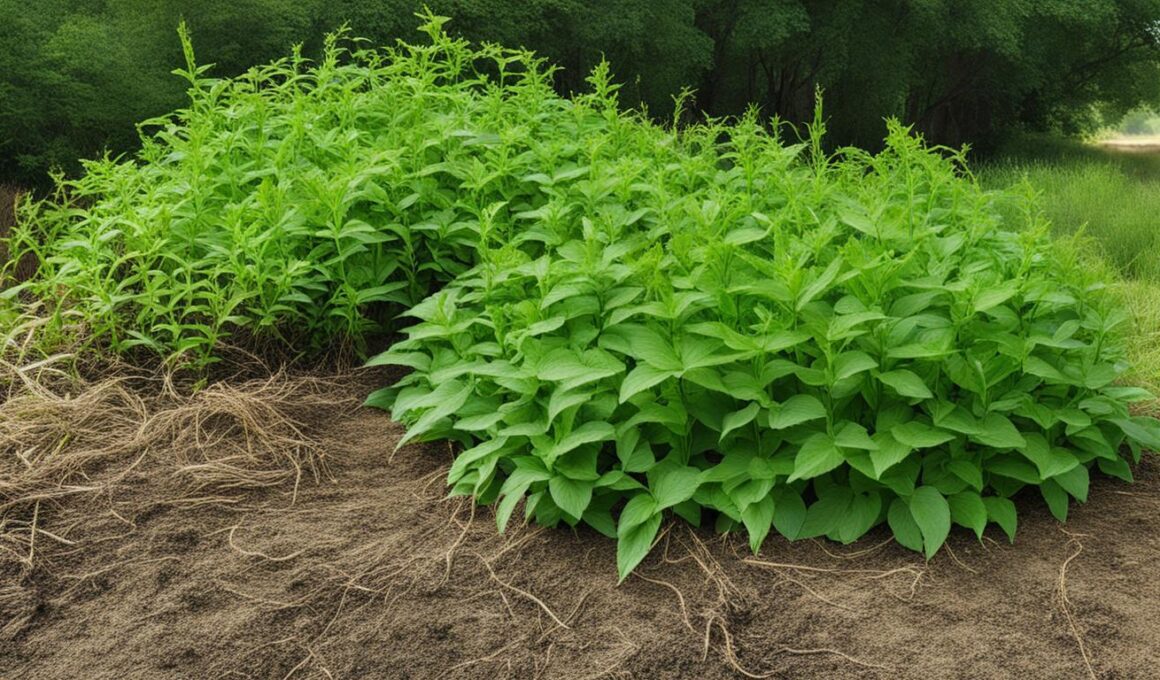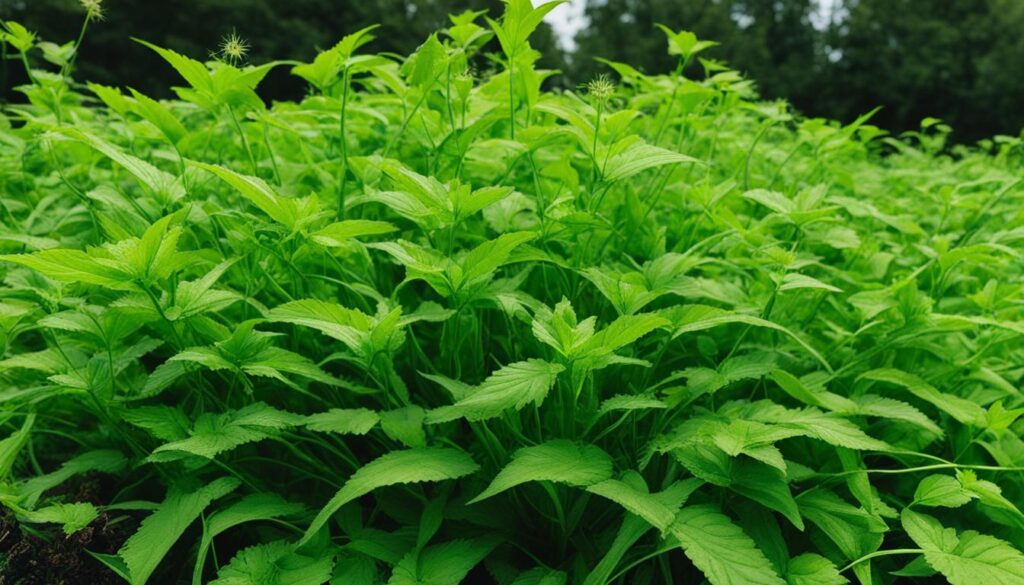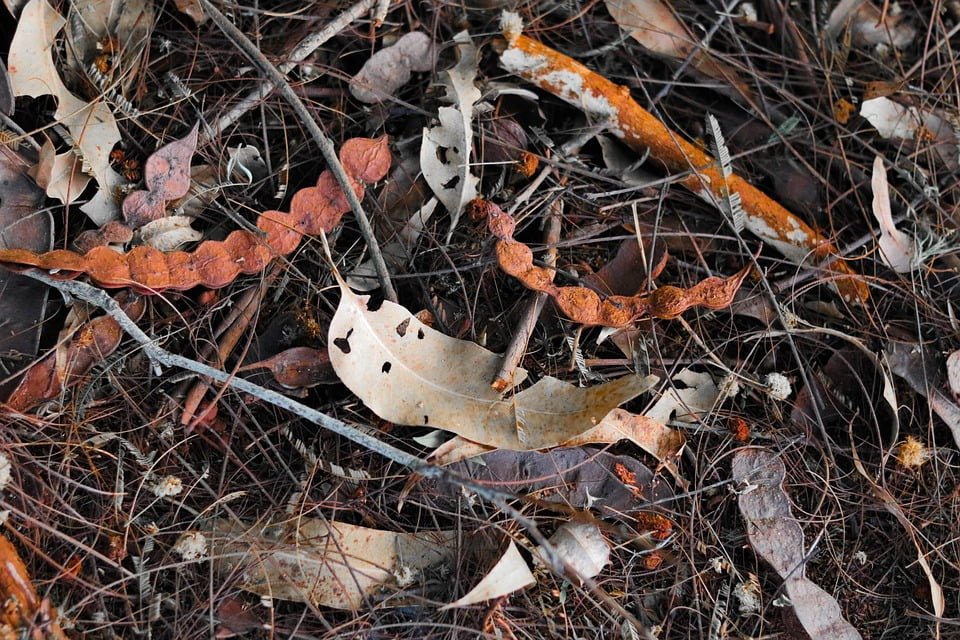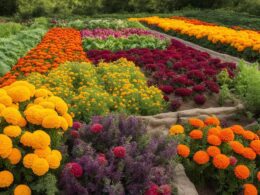Welcome to our comprehensive guide on understanding the impact of weeds on plants. Weeds are not just unwanted plants; they can have detrimental effects on the growth and health of your beloved garden. In this guide, we will explore the characteristics of weeds, methods to control them, and the overall impact they have on your plants and gardens. By the end, you’ll have the knowledge you need to effectively manage weeds and ensure the success of your plants.
But before we dive in, let’s take a moment to understand what exactly weeds are. Weeds are plants that grow in undesired locations, competing with your desired plants for essential resources like water, nutrients, and sunlight. They can hinder the growth of your plants, resulting in stunted or weakened development. Now that you have a basic understanding, let’s explore in more detail.
Key Takeaways:
- Weeds are plants that grow in undesired locations and can deprive your plants of vital resources.
- Identifying weeds correctly is crucial for effective control and management.
- Various methods can be used to control weeds, such as organic solutions, chemical herbicides, or manual removal.
- Weeds can negatively impact plant health and garden aesthetics, competing for resources and hampering growth.
- Observing the types of weeds in your garden can provide insights into soil conditions and necessary changes.
Identification and Characteristics of Weeds
When it comes to maintaining a healthy garden or landscape, identifying and understanding weeds is crucial. Weeds are plants that grow in unwanted locations, often competing with desired plants for resources. To effectively manage weeds, it’s important to be able to identify them and understand their common characteristics.
Weeds can be recognized by their undesired location and certain physical traits. Many weeds have creeping stems that allow them to spread quickly and compete with other plants. Pointed leaves with fine hairs are also common characteristics of weeds. These adaptations help them survive in various environmental conditions, making them resilient and challenging to control.
Some weeds may display tall bamboo-like growth, while others may have small flowers or produce prickly seeds. It’s important to note that weeds can come in many different forms and varieties, making accurate identification crucial. By understanding the common characteristics of weeds, you can effectively differentiate them from desirable plants and take appropriate action to manage their presence.
Methods of Weed Removal
When it comes to removing weeds from your garden, there are several methods you can choose from. Whether you prefer organic solutions, chemical herbicides, or good old-fashioned hand-pulling, each method has its pros and cons.
Organic Weed Removal
If you prefer a natural approach, organic weed removal methods can be effective and environmentally friendly. Pouring boiling water directly onto weeds can scorch and kill them without the use of chemicals. Another option is creating saltwater solutions and applying them to weed-infested areas. These methods are safe for the surrounding plants and soil, but they may require multiple applications and may not be as effective for more established or deeply rooted weeds.
Chemical Herbicides
Chemical herbicides are a popular choice for weed removal, as they can provide quick and efficient results. However, they come with risks and restrictions. It’s important to choose a herbicide that targets the specific types of weeds you’re dealing with while minimizing harm to desirable plants. When using chemical herbicides, be sure to follow the instructions carefully and take necessary precautions to protect yourself, other plants, and the environment.
Hand-pulling Weeds
Hand-pulling weeds may be the least risky method, but it requires more time and effort. It can be an effective technique for young or shallow-rooted weeds, especially when the entire root system is removed. However, some weeds have deep taproots or extensive underground rhizomes, making hand-pulling less effective. Regular maintenance and vigilance are necessary to prevent weed reestablishment.
Remember, the best approach to weed removal may vary depending on the specific weeds in your garden and your personal preferences. Consider a combination of methods to effectively manage weeds and maintain a healthy and thriving garden.
Impact of Weeds on Plants and Gardens
Weeds can have a significant impact on the health and vitality of your plants and gardens. One of the primary ways weeds affect plants is through competition for essential resources. Weeds, like your desired plants, require water, nutrients, and sunlight to thrive. When weeds invade your garden, they compete with your plants for these resources, often resulting in stunted growth or even the death of your desired plants.
Additionally, some weeds have the ability to produce biochemicals that hamper the growth and reproduction of other plant species. These chemicals can inhibit the germination of nearby plants or limit their root development. As a result, weeds can create an unfavorable environment for your garden, making it challenging for your desired plants to flourish.
Invasive weeds can also pose a significant challenge to maintaining a diverse and visually appealing garden. These weeds have the potential to form dense patches or monocultures, outcompeting and crowding out other plant species. This can result in a loss of biodiversity and the creation of a less aesthetically pleasing garden space.
The Impact of Weeds on Plant Health:
- Weeds compete with plants for water, nutrients, and sunlight, leading to stunted growth or death for desired plants
- Some weeds produce biochemicals that inhibit the growth and reproduction of other plant species
- Invasive weeds can overcrowd and dominate garden spaces, reducing biodiversity and visual appeal
To ensure the health and success of your plants and gardens, it is essential to address weed issues promptly and effectively. Implementing a proactive weed control strategy, such as regular monitoring and timely removal of weeds, can help minimize their impact and create a more favorable environment for your desired plants to thrive.
Weeds as Indicators of Soil Conditions
Weeds may often be viewed as a nuisance in gardens and landscapes, but they can provide valuable information about the soil conditions in your garden. Different weed species have specific environmental preferences and requirements, which can indicate the presence of certain soil issues. By observing the types of weeds that thrive in your garden, you can gain insights into the overall health and quality of your soil.
For example, certain weed species such as clover, plantain, or lamb’s quarters thrive in nitrogen-rich soil, indicating a potential excessive fertilizer application or a lack of nitrogen-fixing plants. Weeds like dandelions and thistles indicate compacted soil with poor drainage, while the presence of bindweed or crabgrass may suggest an issue with soil compaction or poor soil structure. Additionally, the growth of weed species like stinging nettle or ground ivy may indicate a high moisture level or poor drainage in the soil.
Identifying the specific types of weeds that appear in your garden can guide you in making necessary soil amendments or management practices. Adding organic matter, such as compost or mulch, can improve soil structure, fertility, and water-holding capacity, making it less favorable for the growth of certain weed species. Proper soil testing can also help identify nutrient deficiencies or imbalances, allowing you to address them and create a healthier growing environment for your desired plants.
Using Weeds to Improve Your Soil
Although weeds are often considered undesirable, some can serve a beneficial purpose in improving soil quality. Certain weed species, such as clover or vetch, are known as green manure plants. These plants can be intentionally grown and then subsequently tilled back into the soil to provide organic matter and nutrient content. This practice helps enhance soil structure and fertility, making it more conducive to the growth of desired plants.
It’s important to note that while observing and understanding the weeds in your garden can provide valuable insights, it’s equally essential to implement effective weed management strategies to prevent their proliferation and competition with desired plants. By combining proper weed control methods, such as mulching, hand-pulling, or targeted herbicide application, with soil improvement techniques, you can create an optimal growing environment for your plants while minimizing weed presence.
Key Takeaways:
- Weeds can indicate specific soil conditions, such as nutrient deficiencies, compaction, or poor drainage.
- Observing the types of weeds in your garden can guide you in making necessary soil amendments or management practices.
- Adding organic matter and conducting soil tests can help improve soil quality and reduce weed growth.
- Some weed species, like clover, can be intentionally grown as green manure plants to enhance soil fertility and structure.
- Effective weed management strategies should be implemented alongside soil improvement techniques for optimal plant growth.
Common Weeds and Their Control
When it comes to maintaining a healthy and thriving garden, it is essential to be familiar with common weeds and know how to control them effectively. Here are some frequently encountered weeds and the best methods for their elimination:
Dandelions
Dandelions can quickly spread and take over lawns, but they can be controlled with proper measures. One method is to pull them by hand, making sure to remove the entire root. If you have dandelions in your lawn, using a broadleaf herbicide specifically formulated for lawns can be an effective solution.
Bindweed
Bindweed is known for its creeping growth habit and can quickly smother other plants. To control bindweed, it is important to remove it as soon as possible. Hand-pulling the weed may be effective, but it may require repeated efforts. Spot treatment with a nonselective herbicide can also be applied, carefully following the product instructions.
Crabgrass
Crabgrass is a common weed that thrives in lawns, particularly in areas with poor soil conditions. To control crabgrass, regular mowing at the correct height can help prevent seed production. Applying a pre-emergent herbicide before crabgrass germination can also be effective. For severe infestations, post-emergent herbicides can be used, but caution should be taken to avoid harming desired grass.
Remember, identifying the specific weed you are dealing with is crucial for effective control. Applying the appropriate control method, whether it involves hand-pulling, herbicides, or preventative measures, is key to keeping common weeds at bay and maintaining a beautiful and flourishing garden.
Conclusion
Weeds can have negative impacts on plants and gardens, competing for resources and potentially choking out desired plants. Understanding the characteristics of weeds, identifying them accurately, and implementing appropriate control methods are essential for maintaining a healthy and thriving garden.
By focusing on weed prevention and employing the right strategies, gardeners can minimize the impact of weeds and ensure the success of their plants. It is important to regularly inspect your garden for any signs of weed growth and take immediate action to remove them. This can include methods such as hand-pulling, using organic weed removal techniques, or using chemical herbicides when necessary.
Remember that different weeds may require different control methods, so it’s crucial to correctly identify the specific weed species and apply targeted measures. By staying vigilant and proactive in managing weeds, you can create a garden environment that promotes the growth and health of your desired plants, while reducing the competition for essential resources.
How Do Weeds Affect Canna Lilies and Calla Lilies?
Weeds can compete with canna lilies vs calla lilies for essential nutrients, water, and sunlight, stunting their growth and reducing their overall health. Weeds can also attract pests that can damage the delicate leaves and blooms of these beautiful flowers. Regular weeding is crucial to keep canna and calla lilies thriving.
FAQ
What are weeds?
Weeds are plants that grow in undesired locations and can negatively affect the growth and health of other plants.
How do weeds harm other plants?
Weeds compete with other plants for essential resources like water, nutrients, and sunlight, often resulting in stunted growth or death of desired plants.
What are some common characteristics of weeds?
Weeds can have creeping stems, pointed leaves with fine hairs, or tall bamboo-like growth. They are often invasive, spread out of control, and grow in the wrong place.
What are the different methods to control weeds?
Some methods of weed control include pouring boiling water on them, using saltwater solutions, using chemical herbicides, or hand-pulling.
What risks come with using chemical herbicides?
Chemical herbicides can be effective, but they come with risks and restrictions that should be carefully considered.
Why is it important to identify specific weeds?
Identifying specific weeds is crucial for effective weed management and implementing targeted control measures.
How can weeds indicate soil conditions?
Different weed species thrive in specific environmental conditions, highlighting issues like nutrient deficiencies, erosion, or compacted soil.
What are some common weeds and how can they be controlled?
Common weeds include dandelions, bindweed, crabgrass, and clover. Each weed requires specific control methods such as hand-pulling, herbicide application, or spot treatment.











